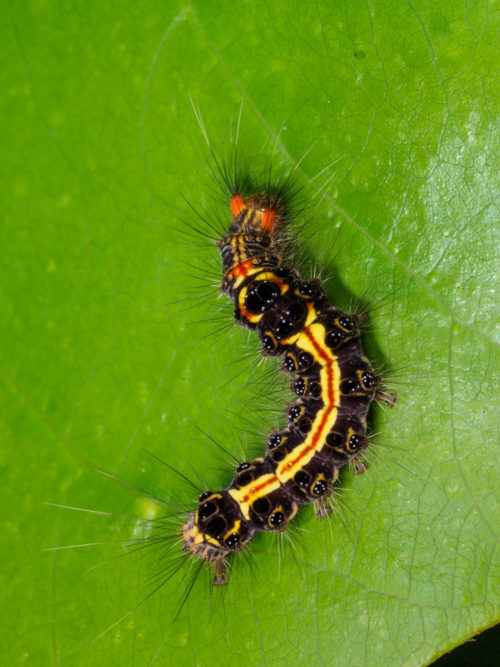
Last year during rainy season I found this caterpillar of Tussock Moth Caterpillar (Orvasca species, Nygmiini, Lymantriinae, Erebidae). I captured it using Olympus OM-D E-M1 Mark II Mirrorless Micro Four Thirds DSLR Camera with Olympus M.Zuiko Digital ED 60mm f/2.8 Macro Lens fitted with Olympus STF-8 Twin Flash.

The Lymantriinae (formerly called the Lymantriidae) are a subfamily of moths of the family Erebidae. Several genera are classified into five tribes, while others remain unclassified (incertae sedis):
- Lymantriini
- Orgyiini
- Nygmiini
- Leucomini
- Arctornithini
- Incertae sedis
This particular moth caterpillar belongs to Tribe Nygmiini, genus Orvasca.

Lymantria means “defiler”, and several species are important defoliators of forest trees, including the gypsy moth Lymantria dispar, the douglas-fir tussock moth Orgyia pseudotsugata, and the nun moth Lymantria monacha. They tend to have broader host plant ranges than most Lepidoptera. Most feed on trees and shrubs, but some are known from vines, herbs, grasses, and lichens.

Many of its component species are referred to as “tussock moths” of one sort or another. The caterpillar, or larval, stage of these species often has a distinctive appearance of alternating bristles and haired projections. Many tussock moth caterpillars have urticating (itchy) hairs (often hidden among longer, softer hairs), which can cause painful reactions if they come into contact with skin.

The subfamily Lymantriinae includes about 350 known genera and over 2,500 known species found in every continent except Antarctica. They are particularly concentrated in sub-Saharan Africa, India, Southeast Asia, and South America.

Adult moths of this subfamily do not feed. They usually have muted colours (browns and greys), although some are white, and tend to be very hairy. Some females are flightless, and some have reduced wings. Usually, the females have a large tuft at the end of the abdomen. The males, at least, have tympanal organs. They are mostly nocturnal, but 20 confirmed diurnal species and 20 more likely diurnal species (based on reduced eye size).

The larvae are also hairy, often with hairs packed in tufts, and in many species, the hairs break off very easily and are extremely irritating to the skin. This highly effective defence serves the moth throughout its lifecycle. The hairs are incorporated into the cocoon. An emerging adult female of some species collects and stores the hairs at the tip of the abdomen and uses them to camouflage and protect the eggs as they are laid. In other species, the eggs are covered by a froth that soon hardens or is camouflaged by the material the female collects and sticks to them. In the larvae of some species, hairs are gathered in dense tufts along the back and this gives them the common name of tussocks or tussock moths. I thank IndanMoths group on facebook, Roger Kendrick & Chinmay C Maliye for helping me to identify this caterpillar.


ಎಲ್ಲಾ ಸರಿ, ಒಂದು ರೂಪಾಂತರಗೊಂಡ ಮಾದರಿಯನ್ನೂ (ಸದ್ಯ ನಿಮ್ಮ ‘ಸೆರೆ’ಗೆ ಸಿಗುವಂತಿಲ್ಲವಾದ್ದರಿಂದ) ಜಾಲದಿಂದಾದರೂ ತೆಗೆದು ಹಾಕಿದ್ದರೆ ನನ್ನಂಥ ಸಾಮಾನ್ಯರಿಗೆ ತತ್ಕಾಲೀನ ತೃಪ್ತಿ ಸಿಗುತ್ತಿತ್ತು